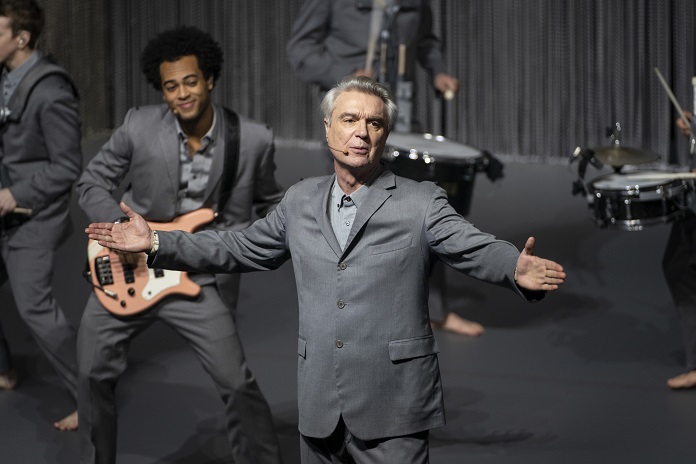
David Byrne’s American Utopia [NYFF 2020]
Studio: HBO
Directed by Spike Lee
Oct 05, 2020
Web Exclusive
![]()
In October 2019, after an incredibly successful tour of his 2018 album, American Utopia, iconic music figure David Byrne turned to Broadway. For five months, David Byrne’s American Utopia thrived at New York City’s Hudson Theater alongside Great White Way staples such as The Lion King and Hamilton, playing to sold-out audiences throughout its run.
The idea behind the show is simple. No set pieces, no wires attached to anyone’s backs, just Byrne and an 11-person ensemble. Dressed in monochromatic grey suits and barefoot, they perform like a marching band, with their instruments strapped to their body. All the while they are dancing in sync to Annie-B Parson’s expressive choreography, against a similarly monochromatic backdrop of a shimmery grey curtain. The show includes both Byrne originals and hits from his trailblazing band, Talking Heads. These are mixed with Byrne’s political commentary, musings and monologues.
The show transfers smoothly to film. Directed by Spike Lee, it is essentially a concert film, albeit an artistic one. The film revels in the show’s simplicity. Filmed at the Hudson Theater, it opens with Byrne sitting on a chair holding a model of a human brain, he dedicates the first song “Here” to it. As the songs progress, Byrne explores the ideas of human connection while more and more members of his ensemble enter the stage. The final three performers arrive in grand style during the wonderful rendition of Talking Heads’ catchy “I Zimbra.”
This tactic of slowly introducing the performers references Talking Heads’ 1984 concert film, Stop Making Sense – recognized as one of the greatest concert films. While the two films are similar in style, American Utopia has a self-reflection that Stop Making Sense doesn’t have. It often feels like Byrne is contemplating his past while simultaneously focusing on his future, both as a performer and as a person.
Even when the full band is present, the stage is still bare, which in itself, has a strong impact on the viewer. As Byrne explains during one of his monologues, the goal of the empty stage design is to put the spotlight on the band, their music, and their relationship with the audience. “It’s just us and you,” he says. To the film’s credit, it always feels that way. Translating the communal and connective feeling that comes with live shows into a stage recording is a difficult task. It is the ensemble’s inherent charisma and Lee’s use of different shots and close-ups that makes viewers feel like they are in a row of the Hudson Theater, tapping their feet and dancing along with everyone else in the crowd.
When the band isn’t playing, Byrne keeps the audience entertained. He contemplates the idea of human connection, explains the backstory of certain songs and strikes political tones. Midway through the show, he gives a monologue about voting in both national and local elections, mentioning the voting registration table at the front of the theater. He uses the audience to demonstrate how low voter turnout is, especially in local elections. “Here are 20 percent of the people in this theater,” he says, pointing at a sliver of people sitting at the leftmost section of the three-tiered auditorium. “Here they are. These are the ones that vote.” Byrne’s monologues are conversational and joke-filled, providing a breather for both the band and audience as the show transitions from hit to hit.
Byrne and Lee always make sure the show’s themes are at the forefront of what is happening on film. Early in the performance, halfway through “I Should Watch TV,” an image of Colin Kaepernick flashes behind Byrne and company as they take a knee. “How am I not your brother? / How are you not like me?” Byrne sings. Near the end of the show, they cover Janelle Monaé 2015 protest song, “Hell You Talmbout.” The song’s lyrics list the names of innocent Black Americans killed at the hands of racism and police brutality. As members from the ensemble shout names out followed by “say his name” or “say her name” from the entire group, the film cuts to an image of each person, along with their date of birth and death. When the song comes to a close, Lee fills the screen with the images of Ahmaud Arbery, Breonna Taylor, and George Floyd; along with an additional title card with 22 lines of names in red font, along with the words “and too many more.” The idea of an “American Utopia” is an oxymoron, and Byrne and Lee emphasize that in an emotional, powerful, and affecting way through song lyrics, imagery and speeches.
With American Utopia, Byrne is in complete control. Each move is precisely calculated, each beat of a drum or strum of a guitar is perfectly timed, and each message is carefully spelled out in a way that resonates with viewers. For 105 minutes, audiences are immersed into a different kind of utopia: empty stage space filled with catchy songs, fun dancing, and a lot of grey suits. When it’s this entertaining and beautifully choreographed on top of that, it’s impossible to look away from, straight through the credits where Byrne exits the stage door with his bicycle and rides away through the streets of New York. With Stop Making Sense, David Byrne proved that he could captivate audiences regardless of if they were seeing him in person or on-screen. 36 years later, David Byrne reaffirms that he’s still got it, and as the hit song suggests, “This must be the place.”
(www.filmlinc.org/nyff2020/films/david-byrnes-american-utopia/)
Author rating: 8.5/10
Average reader rating: 10/10
Current Issue

Issue #72
Apr 19, 2024 Issue #72 - The ‘90s Issue with The Cardigans and Thurston Moore

Comments
Submit your comment
There are no comments for this entry yet.